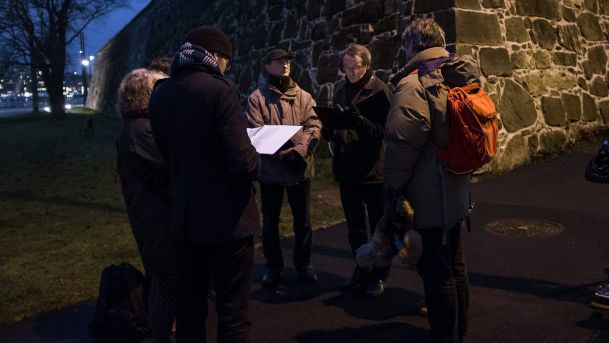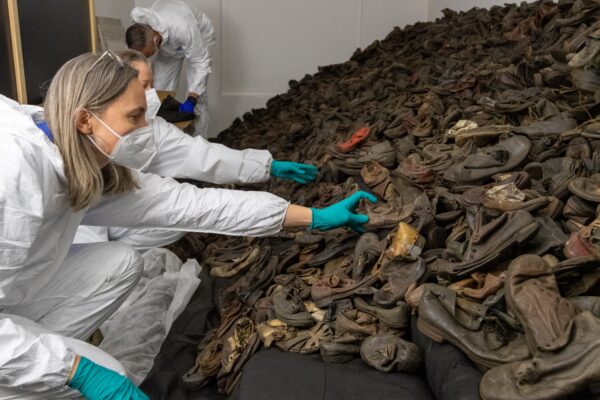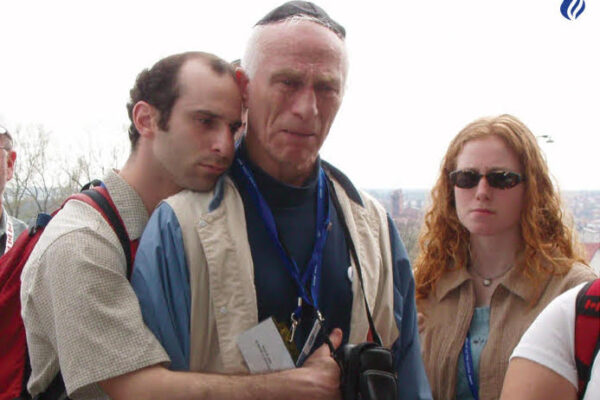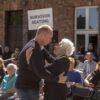It took 45 minutes for the twelve people to read out the names of 767 Norwegian Jews deported by the Norwegian authorities during the Nazi occupation.
By Lene Johansen

Twelve people are standing in a circle under a streetlight at the base of the historic fortress in the center of Oslo. It is only 4 p.m., but it is already pitch dark outside. It would not have been so dark if it had snowed, but the temperature has not dropped far enough yet. They are standing in the shadow of the tall, steep fortress walls. The pier across the street is where cruise boats anchor up during the summer months, but the area is quiet and desolate this time of day in late November.
The transport ship SS Donau was anchored on that pier on November 26, 1942. The pier belonged to the Norwegian America Line, but on that day, the German occupation force had procured it for its own use. At 2:55 p.m. the ship set sail out of the Oslofjord, heading for Stettin in occupied Poland. The cargo was people. This was the first and largest deportation of Norwegian Jews during the Second World War.
About one third of the Norwegian Jewish population was stowed into two cargo holds under the deck, 302 men, 188 women, and 42 children.
The youngest child, Jan Larry Krupp, was only four months old. Another one of the children was twoyear old Ruth Sakolsky from Tromsø, above the polar circle. Her mother was 38 years old. She and her husband had wanted a child for a long time. The oldest one was Olga Scheer, who was 80 years old. They hit bad weather around the narrowest part of the fjord at Drøbak, and many got sick. The hopes of being sent to a work camp up north vanished as the lights from the Swedish west coast kept following them on the porthand side.
All the women and children were sent directly to the gas chamber when they arrived in Auschwitz five days later. Nine men would survive and return to Norway at the end of the war. The last of these, Samuel Steinmann, died earlier this year. He spent time talking to school children about his experience up until his death.
About half of the community of Norwegian Jews was sent off to the death camps during World War 2, only 30 returned. 200 families were wiped out. This is why these twelve people are standing there on that street corner on a cold and dark afternoon in November.
They are reading the names of each one of the 767 Norwegian Jews deported by the Norwegian authorities during the occupation.
There is a memorial to the Holocaust victims on the lawn besides the streetlight. Several empty chairs with no seats are scattered across the lawn. They are empty, because the people who were supposed to sit in the chairs were sent off to their death. There are no seats in the chairs, because there was no respite for any of those people.
Name, hometown, and age. There is a binder being passed around the circle with all the names. Each person reads the name, hometown, and age of ten people before the binder is passed to the next person in the circle. At some point, the voice of an elderly woman cracks. She starts over. It cracks again. On her third try, she is able to complete the entry with a clear voice.
I knew that person, she whispers apologetically.
She completes the ten names and passes the binder to the person on her right. Name, hometown, and age. The binder continues its rounds around the circle until each person has been mentioned.
It takes 45 minutes to complete the reading, before people hesitatingly break the circle and wander off into the cold night to go about their lives.
The sobriety of the moment is on their minds, but there is also a sense of accomplishment, of having completed something important. Next year, they will meet again. Repeat the ritual. And get on with living. You shall tell your children.
Lene Johansen is a Norweigian journalist who has appeared on NPR, in Reason Magazine and the Columbia Journalism Review as well as Norwegian news outlets and trade publications. Follow her on Twitter: @lenejohansen
Article originally published HERE.







